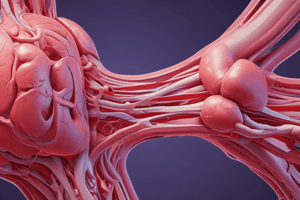Podcast
Questions and Answers
Which of the following factors is NOT a risk factor for arterial insufficiency ulcers?
Which of the following factors is NOT a risk factor for arterial insufficiency ulcers?
- Obesity
- High physical activity levels (correct)
- Diabetes
- Smoking
What ankle-brachial index (ABI) value indicates better prognosis for arterial insufficiency ulcers?
What ankle-brachial index (ABI) value indicates better prognosis for arterial insufficiency ulcers?
- <0.3
- 0.5 - 0.8
- >0.8
- >0.5 (correct)
Which of the following statements regarding the prognosis of arterial insufficiency ulcers is true?
Which of the following statements regarding the prognosis of arterial insufficiency ulcers is true?
- Not observing a wound healing within 2 weeks necessitates a change in plan of care. (correct)
- A wound that does not decrease in size after 2 weeks should be aggressively treated with standard care.
- Transcutaneous oxygen levels greater than 30 mmHg indicate a poor prognosis.
- A toe pressure of 30 mmHg predicts a positive prognosis.
What is a common requirement for all open wounds, particularly those that might indicate arterial insufficiency?
What is a common requirement for all open wounds, particularly those that might indicate arterial insufficiency?
Which of the following complications is associated with vascular wounds specifically?
Which of the following complications is associated with vascular wounds specifically?
What is the maximum time allowed for capillary refill to be considered normal?
What is the maximum time allowed for capillary refill to be considered normal?
What indicates arterial insufficiency based on the rubor of dependency test?
What indicates arterial insufficiency based on the rubor of dependency test?
Which treatment is recommended for deep tissue infections?
Which treatment is recommended for deep tissue infections?
What is the normal venous filling time range?
What is the normal venous filling time range?
What type of dressing is suitable for arterial ulcers with minimal exudate?
What type of dressing is suitable for arterial ulcers with minimal exudate?
Which of the following should be avoided in patients with an ABI greater than 0.80?
Which of the following should be avoided in patients with an ABI greater than 0.80?
What is the least harmful wound cleanser for mildly infected wounds?
What is the least harmful wound cleanser for mildly infected wounds?
What condition should prompt referral to a vascular surgeon?
What condition should prompt referral to a vascular surgeon?
Flashcards are hidden until you start studying
Study Notes
Vascular Wounds
-
Arterial Insufficiency Ulcers are caused by insufficient blood flow to the extremities, leading to wounds that are slow to heal (if at all).
-
Risk Factors for Arterial Insufficiency Ulcers:
- Atherosclerosis
- Overweight and Obesity
- Diabetes
- Smoking
- Hypertension
- Age
- Cardiovascular Disease
-
Prognosis for Arterial Insufficiency Ulcers:
- Good Prognosis: Ankle Brachial Index (ABI) > 0.5, Toe Pressure > 50 mmHg, Transcutaneous Oxygen Levels > 30 mmHg.
- Poor Prognosis: If wound doesn't decrease in size or heal within 2 weeks, referral to a vascular surgeon is needed.
-
Pulse Examination: Is essential for all open wounds.
Assessing Vascular Status
-
Capillary Refill Test:
- Normal: Blood returns in 3 seconds or less.
- Impaired: Blood returns after more than 3 seconds.
-
Venous Filling Time:
- Normal: 15-20 seconds.
- Arterial Insufficiency: >15-30 seconds.
-
Rubor of Dependency Test:
- Normal: Color returns to the foot within 15 seconds.
- Arterial Insufficiency: Color returns after 30 seconds and turns bright red.
Wound Management:
-
Infection Control:
- Ischemic wounds are susceptible to bacterial infections.
- Consider bacterial swab if classical signs of infection aren't present.
- Topical treatments: Silver dressings, cadexomer iodide.
- Deep tissue infections: Systemic antibiotics.
-
Wound Cleansing:
- Use 0.9% saline for wound cleansing - other solutions can be toxic.
-
Dressing:
- Arterial ulcers have minimal exudate and fragile surrounding skin.
- Use moist, non-adherent dressings with antimicrobial properties.
Precautions for Patients with Arterial Insufficiency
-
Compression therapy:
- Avoid high compression (30-40 mmHg) if ABI is above 0.80.
- Avoid compression dressings for patients with ABI greater than 0.50 - Refer to a vascular surgeon.
-
Debridement:
- Never use sharps to remove debris from wounds with low ABI.
Pressure Ulcers and Risk Factors
-
Impaired Sensation:
- Lack of pain as an early warning sign of tissue ischemia.
- Individuals with impaired sensation are less likely to reposition themselves, making pressure ulcers more likely.
- Common causes: Spinal cord injuries, Spina Bifida, Stroke, Full thickness burns, and Peripheral Neuropathy.
-
Impaired Mobility:
- Hospitalization, diagnosis, and surgery can contribute to mobility issues.
- Typically occurs within 3 weeks of surgery and within 1 week of admission to a nursing home.
-
Previous Pressure Ulcer:
- Scar tissue is 80% as strong as the original tissue.
- Scar tissue + pressure injury = reduced tolerance to external load.
-
Other Risks: Individuals with high Diastolic Blood Pressure (DBP) are at increased risk.
Studying That Suits You
Use AI to generate personalized quizzes and flashcards to suit your learning preferences.




